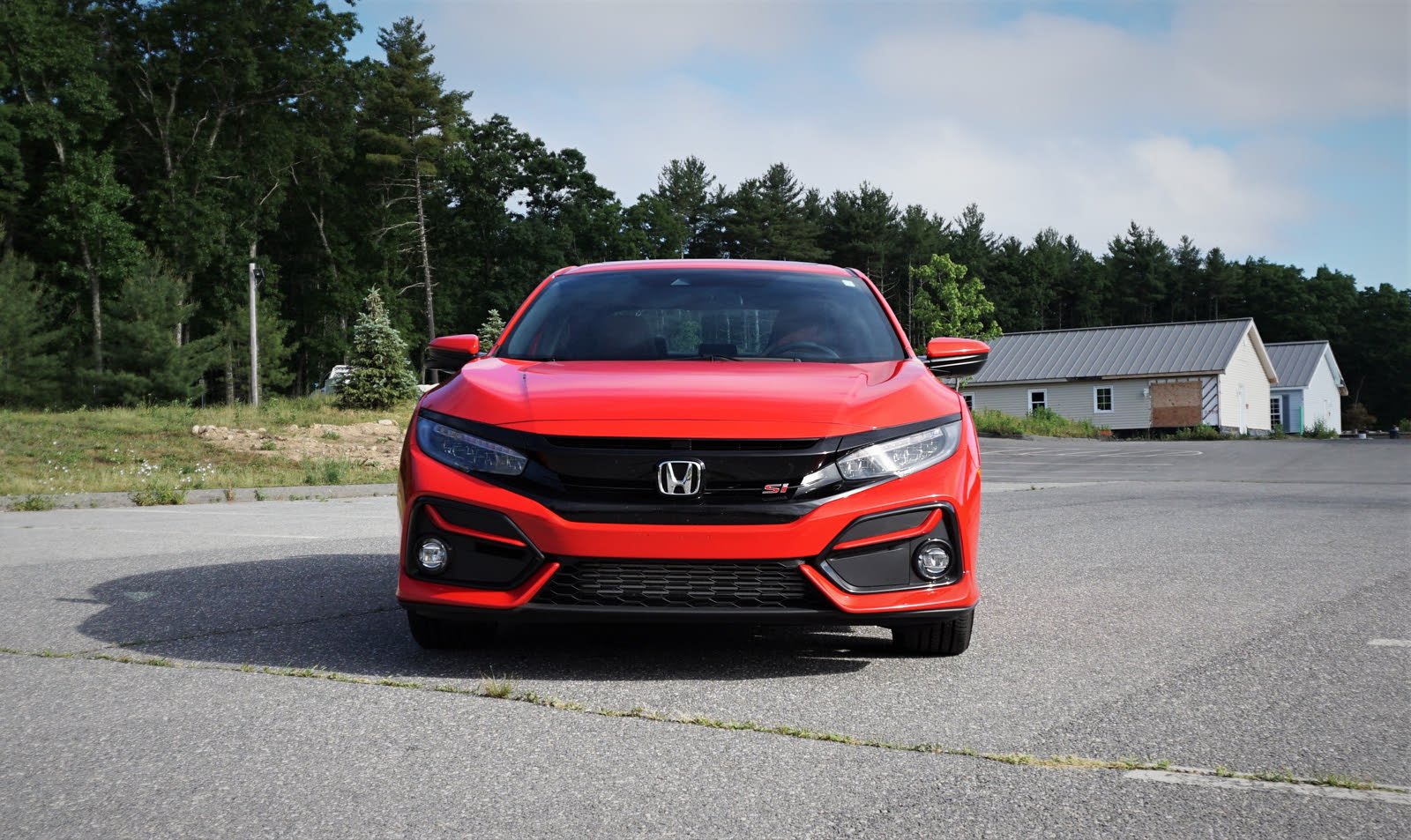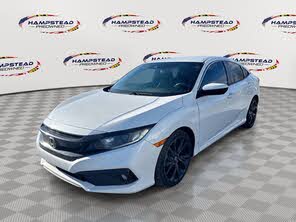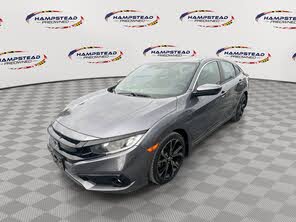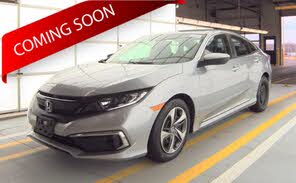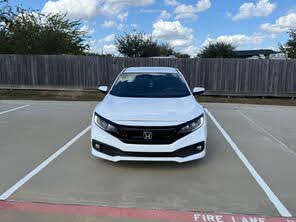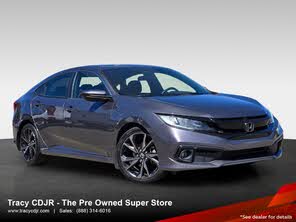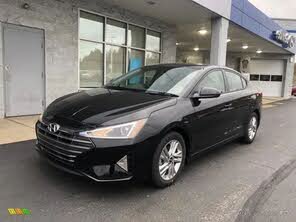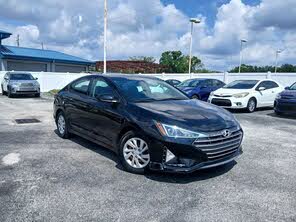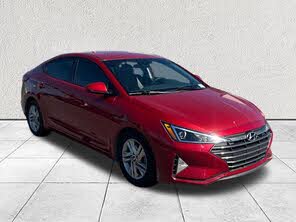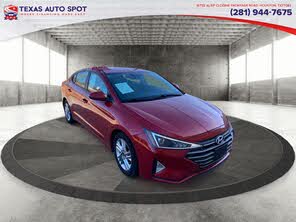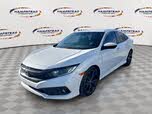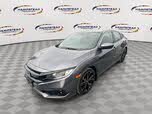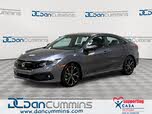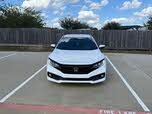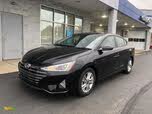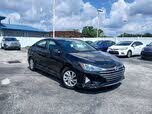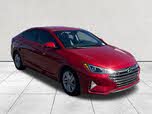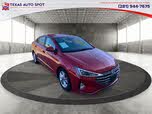2020 Honda Civic vs 2020 Hyundai Elantra
Overview | |
MSRP$19,300 | MSRP$20,000 |
Listings1052 | Listings1577 |
Ratings & Reviews | |
User Reviews | User Reviews |
Expert reviews8.3 out of 10 | Expert reviews8.2 out of 10 |
Pros
Cons
| Pros
Cons
|
2020 Hyundai Elantra Reviews SummaryHyundai isn’t pulling any punches when it comes to the compact car segment, where value is of utmost importance. And though a completely redesigned 2021 Elantra is coming soon, the automaker bestows several value-enhancing improvements upon the outgoing 2020 Hyundai Elantra compact sedan. They include free scheduled maintenance, improved fuel economy ratings, and new standard safety features. | |
2020 Honda Civic Reviews SummaryMinor design tweaks, more standard safety and convenience features, and more manual transmissions arrive as the standout changes for the Civic's 2020 model year. Last redesigned for the 2016 model year, the Civic keeps outperforming its small-car peers by offering the performance and quality of more expensive cars, while retaining the value and longevity expected of a Honda. Plus, I had a really fun week with the turbocharged Civic Si. | |
No video found | |
Popular Features & Specs | |
Engine2.0L 147 hp I4 | Engine2.0L 158 hp I4 |
Drive TrainFWD | Drive TrainFWD |
Seating Capacity5 | Seating Capacity5 |
Horsepower147 hp @ 6200 rpm | Horsepower158 hp @ 6500 rpm |
MPG City31 | MPG City25 |
MPG Highway41 | MPG Highway36 |
Engine | |
Engine Name2.0L 147 hp I4 | Engine Name2.0L 158 hp I4 |
Torque132 lb-ft @ 4500 rpm | Torque138 lb-ft @ 4200 rpm |
Horsepower147 hp @ 6200 rpm | Horsepower158 hp @ 6500 rpm |
DrivetrainFWD | DrivetrainFWD |
Fuel Economy | |
MPG City31 | MPG City25 |
MPG Highway41 | MPG Highway36 |
Interior | |
Seating Capacity5 | Seating Capacity5 |
Safety | |
Front Crash Overall4 | Front Crash Overall5 |
Side Crash Overall4 | Side Crash Overall5 |
Dimensions & Capacity | |
Cargo Space14.4 cu ft | Cargo Space15.1 cu ft |
Curb Weight2844 lbs | Curb Weight2762 lbs |
Height56.5 in | Height55.7 in |
Length181.9 in | Length182.7 in |
Width70.9 in | Width70.8 in |
Wheelbase106.3 in | Wheelbase106.3 in |
Maximum Payload1080 lbs | Maximum Payload1007 lbs |
Number of doors4 | Number of doors4 |
Overview | ||
MSRP | $19,300 | $20,000 |
Listings | ||
Ratings & Reviews | ||
User reviews | ||
Expert reviews | 8.3 out of 10Read full review | 8.2 out of 10Read full review |
Pros & cons | Pros
Cons
| Pros
Cons
|
Summary | Hyundai isn’t pulling any punches when it comes to the compact car segment, where value is of utmost importance. And though a completely redesigned 2021 Elantra is coming soon, the automaker bestows several value-enhancing improvements upon the outgoing 2020 Hyundai Elantra compact sedan. They include free scheduled maintenance, improved fuel economy ratings, and new standard safety features. | Minor design tweaks, more standard safety and convenience features, and more manual transmissions arrive as the standout changes for the Civic's 2020 model year. Last redesigned for the 2016 model year, the Civic keeps outperforming its small-car peers by offering the performance and quality of more expensive cars, while retaining the value and longevity expected of a Honda. Plus, I had a really fun week with the turbocharged Civic Si. |
Video | No video found | |
Popular Features & Specs | ||
Engine | 2.0L 147 hp I4 | 2.0L 158 hp I4 |
Drive Train | FWD | FWD |
Seating Capacity | 5 | 5 |
Horsepower | 147 hp @ 6200 rpm | 158 hp @ 6500 rpm |
MPG City | 31 | 25 |
MPG Highway | 41 | 36 |
Engine | ||
Engine Name | 2.0L 147 hp I4 | 2.0L 158 hp I4 |
Torque | 132 lb-ft @ 4500 rpm | 138 lb-ft @ 4200 rpm |
Horsepower | 147 hp @ 6200 rpm | 158 hp @ 6500 rpm |
Drivetrain | FWD | FWD |
Fuel Economy | ||
MPG City | 31 | 25 |
MPG Highway | 41 | 36 |
Interior | ||
Seating Capacity | 5 | 5 |
Safety | ||
Front Crash Overall | 4 | 5 |
Side Crash Overall | 4 | 5 |
Dimensions & Capacity | ||
Cargo Space | 14.4 cu ft | 15.1 cu ft |
Curb Weight | 2844 lbs | 2762 lbs |
Height | 56.5 in | 55.7 in |
Length | 181.9 in | 182.7 in |
Width | 70.9 in | 70.8 in |
Wheelbase | 106.3 in | 106.3 in |
Maximum Payload | 1080 lbs | 1007 lbs |
Number of doors | 4 | 4 |
The 2020 Hyundai Elantra, last redesigned in 2017 and restyled in 2019, remained visually unchanged for the 2020 model year. The previous year's restyle introduced a geometric-influenced appearance, setting the stage for the dramatically angular styling of the upcoming 2021 Elantra. Available in six versions—SE, SEL, Value Edition, Eco, Limited, and Sport—the Elantra's price ranged from $19,300 to $24,150. The Limited test vehicle, equipped with the Ultimate Package and floor mats, brought the total to $27,630, including the $975 destination charge. The Elantra GT hatchback was also available for 2020. A black paint job highlighted the car's angular headlight, fog light, and wheel designs, contrasting with the chrome grille and detailing, resulting in a stylish, albeit polarizing, small car.
Inside, the Elantra's restyled exterior was complemented by an updated interior aimed at a more upscale look. Silver trim adorned various elements, including the air vents, climate control panel, engine start button, and steering wheel. However, the presence of hard and glossy plastics served as a reminder of the car's mainstream compact status. The Elantra Limited's interior, while stylish, balanced upscale touches with practical, cost-effective materials.
The 2020 Honda Civic, a crown jewel in Honda's lineup, was a $20,000 compact car that offered a bounty of choices and engineering excellence typically found in higher-end brands. Available in three body styles—sedan, coupe, and 4-door hatchback—the Civic's sharp design drew attention away from its small footprint. The sedan featured a svelte roofline, while body panel creases and wide, arcing headlights accentuated its low and wide stance. The hatchback's tall rump was quirky, and the Type R was an exaggerated, anime-like car. The 2019 model year upgrades to grilles, bumpers, and wheels carried over to 2020, with the Civic Si sedan and coupe receiving new matte-black 18-inch wheels, LED fog lights, standard LED headlights, an updated grille, and a new rear bumper.
Inside, the Civic's simple interior featured a narrow center stack and minimal instrumentation, built with soft-touch rubbers and high-quality switchgear. Hard plastics on the lower sections of the dash and doors were acceptable, with a fine grain. Gloss-black trim on the steering wheel and dash, a metal shift knob, and a pulsing red start button added visual appeal. Interior styling changes for 2020 included new dash accents on the hatchback and a thin red line on the Si's instrument panel. The Si also received revised sport seats with red bands woven into the fabric.




The 2020 Hyundai Elantra featured a base 147-horsepower, 2.0-liter four-cylinder engine paired with a new continuously variable transmission (CVT), replacing the previous six-speed automatic. The CVT, standard with SE trim, contributed to a $1,100 price increase from the previous year. All Elantra models were front-wheel drive. The Elantra Eco model had a turbocharged 1.4-liter four-cylinder engine producing 128 horsepower and 156 lb-ft of torque, paired with a seven-speed dual-clutch automatic transmission (DCT) and an automatic engine start/stop system, achieving 36 mpg in combined driving. The Elantra Sport trim featured a 1.6-liter turbo four-cylinder engine with 201 horsepower and 195 lb-ft of torque, an independent rear suspension, and a seven-speed DCT.
The Elantra Limited test car, with its 2.0-liter engine and new CVT, provided a satisfactory driving experience. Hyundai's "Intelligent Variable Transmission" offered simulated gear shifts, making it feel like a traditional automatic. The CVT's chain belt and wide-ratio pulley system improved efficiency and responsiveness. However, real-world fuel economy fell short, averaging 29.3 mpg compared to the expected 34 mpg. The Elantra's torsion beam axle rear suspension detracted from ride and handling, giving the car an unsettled feeling. The Elantra Sport's independent rear suspension provided a superior ride and more enjoyable driving experience.
The 2020 Honda Civic offered four engines and two transmissions across its lineup, all front-wheel drive. The base LX and Sport trims had a 2.0-liter inline 4-cylinder engine with 158 horsepower and 138 lb-ft of torque, paired with a 6-speed manual transmission or an optional CVT. The EX and higher trims featured a turbocharged 1.5-liter inline-4 engine with 174 horsepower and 162 lb-ft of torque, with the hatchback's Sport and Sport Touring trims producing 180 horsepower. The Civic Si had a 1.5-liter engine boosted to 205 horsepower and 192 lb-ft, while the Type R boasted 306 horsepower and 295 lb-ft, both with a stick-shift.
The 1.5-liter engine provided greater mid-range acceleration and responsiveness, with smooth, quick-revving performance. The CVT responded well without hesitation, and the manual transmission offered a tight, enjoyable shifting experience. The Civic Si's adaptive dampers reduced body roll, providing a balanced and direct driving experience. The Type R, with its immense power, remained composed despite its ultra-thin tires. The Si's shorter final-drive ratio improved acceleration but slightly reduced fuel economy, rated at 26 mpg city, 36 mpg highway, and 30 mpg combined. Most Civic models with the CVT achieved at least 30 mpg city and up to 42 mpg highway.
The 2020 Hyundai Elantra offered roomy accommodations for four adults, with a fifth person fitting for short trips. The Limited test car featured power driver’s seat adjustment, leather upholstery, and a sliding center console armrest for added comfort. A front passenger's seat-height adjuster was standard across all trims. The Elantra included a dual-zone automatic climate control system with a Clean Air ionizer and automatic defogging system. Heated front seats were available on all but the SE and SEL trims, though rear air conditioning vents were absent. Interior storage was well-proportioned, and the trunk provided 14.4 cubic feet of space, nearly matching some midsize sedans. A thoughtful touch was the interior grab handle inside the trunk lid.
The 2020 Honda Civic's interior improvements included a volume knob and better cupholders. The hatchback had more sound insulation in the floor, trunk, and wheel wells. EX hatchback models featured an eight-way power-adjustable driver's seat. The three-spoke steering wheel had controls for the central display and instrument panel, with easy access to various functions. The Civic retained a conventional PRNDL shifter and electronic parking brake. The center console offered configurable storage with item trays and cupholders. The Civic felt roomy for rear passengers, with two-stage heated outboard seats available, though rear air vents were missing. The sedan's trunk provided 15 cubic feet of cargo space, while the coupe had 12 cubic feet. The hatchback offered 26 cubic feet behind the rear seats and 46 cubic feet with them folded down.
The 2020 Hyundai Elantra came standard with a touchscreen infotainment system, Bluetooth, and a USB port. The base SE trim had a 5-inch screen, while the SEL and higher trims featured a 7-inch display with Apple CarPlay, Android Auto, and SiriusXM satellite radio. The Value Edition included a complimentary subscription to Blue Link Connected Car and Remote plans for three years. The Limited trim added wireless smartphone charging and a premium Infinity sound system. The Ultimate Package increased the touchscreen size to 8 inches and added navigation, Blue Link Guidance service, and SiriusXM data services. The Sport trim offered similar upgrades, packaged differently. The infotainment system was user-friendly, with a high-mounted display, shortcut buttons, and volume and tuning knobs. The Infinity sound system impressed with its depth of sound.
The 2020 Honda Civic's infotainment system felt outdated, running slower and looking graphically dated compared to newer Honda models. The 7-inch touchscreen, standard on all but the base LX, included Apple CarPlay and Android Auto. Top-end trims featured Garmin-based navigation with accurate voice recognition. The Civic Si introduced Active Sound Control, which pumped fake engine sounds through the speakers, though it could be turned off. The Si also came with push-button start, keyless entry, power moonroof, and heated front seats. LaneWatch, a right-side mirror camera, provided a live feed of the blind spot. Automatic climate control was standard, and Si models received Honda Sensing, which included active lane centering, adaptive cruise control, and auto high beams. Leather upholstery was available on the EX-L sedan and hatchback, while rain-sensing wipers were included on the Touring trim. LED headlights were standard on Touring, Si, and Sport Touring models.
The 2020 Hyundai Elantra featured Hyundai Smart Sense as standard on all trims, including forward-collision warning, automatic emergency braking, lane departure warning, lane-keeping assist, and a driver attention monitor. Starting with the SEL trim, the Elantra added blind-spot warning and rear cross-traffic alert. The Limited and Sport trims included full LED headlights with automatic high-beam operation. The Ultimate Package for the Limited trim added adaptive cruise control, a pedestrian detection system, and Safe Exit Assist. The Elantra earned a Top Safety Pick from the IIHS when equipped with full LED headlights and received a four-star overall rating from the NHTSA, with a noted concern about rear-door intrusion during the side-impact test.
The 2020 Honda Civic came with Honda Sensing, which included forward collision warning, emergency forward braking, lane-keeping assist, and adaptive cruise control. Improvements to the optional LED headlights helped the Civic earn a Top Safety Pick rating from the IIHS for all body styles except the Type R. The Civic received the top "Good" rating in all six crash tests. The NHTSA rated the 2020 Civic five stars in all categories, except for four stars in the passenger frontal crash rating on the coupe.
CarGurus highlights

According to CarGurus experts, the overall rating for the 2020 Hyundai Elantra is 8.3 out of 10, while the 2020 Honda Civic scores 8.2 out of 10. Based on these ratings, the 2020 Hyundai Elantra is the recommended choice, offering a slightly higher overall rating and a well-rounded package of style, technology, and safety features.
Choose the 2020 Honda Civic if:
- You value a variety of body styles and engine options, including high-performance variants.
- You prefer a roomy interior with configurable storage and high-quality materials.
- You want advanced safety features and a Top Safety Pick rating from the IIHS.
Choose the 2020 Hyundai Elantra if:
- You prioritize a stylish design with a geometric-influenced appearance.
- You want a compact car with a user-friendly infotainment system and premium sound.
- You seek a vehicle with comprehensive safety features, including Hyundai Smart Sense.
CarGurus highlights

According to CarGurus experts, the overall rating for the 2020 Hyundai Elantra is 8.3 out of 10, while the 2020 Honda Civic scores 8.2 out of 10. Based on these ratings, the 2020 Hyundai Elantra is the recommended choice, offering a slightly higher overall rating and a well-rounded package of style, technology, and safety features.
Choose the 2020 Honda Civic if:
Shop Now- You value a variety of body styles and engine options, including high-performance variants.
- You prefer a roomy interior with configurable storage and high-quality materials.
- You want advanced safety features and a Top Safety Pick rating from the IIHS.
Choose the 2020 Hyundai Elantra if:
Shop Now- You prioritize a stylish design with a geometric-influenced appearance.
- You want a compact car with a user-friendly infotainment system and premium sound.
- You seek a vehicle with comprehensive safety features, including Hyundai Smart Sense.

By: CarGurus + AI
At CarGurus, our team of experienced automotive writers remain at the heart of our content operation, conducting hands-on car tests and writing insightful guides that are backed by years of industry experience. To complement this, we are harnessing AI to make our content offering more diverse and more helpful to shoppers than ever. To achieve this, our AI systems are based exclusively on CarGurus content, ratings and data, so that what we produce is both unique to CarGurus, and uniquely helpful to car shoppers.
